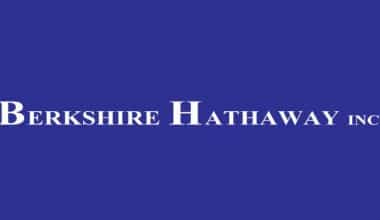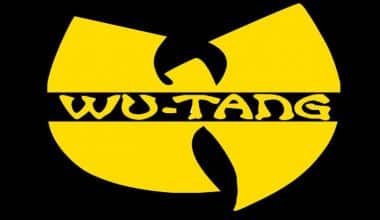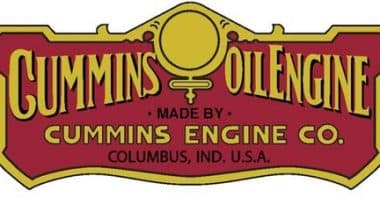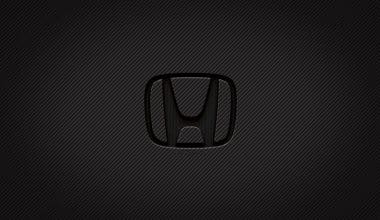John Deere was founded in 1837, but it was not until 1876 that its first logo was established. Since then, both John Deere and its logo have undergone a lot of evolution, even as the brand produces more tractors and other farm machinery. Read on to learn more about the history and evolution of the great John Deere brand logo.
History and Evolution of The John Deere Logo
The history of the John Deere logo dates back to the late 1870s. The corporation had been around for a while, and after a brief period of success and then failure, the activities in Illinois began to cement and consolidate. After considerable thought, John Deere registered a logo in 1876: the “leaping deer” trademark.
1876
The logo had been in use for three years when it was registered in 1876. At the time, the company was producing over 60,000 plows per year, and it was viewed as a vital step to defend against copying and deceit. The original John Deere logo included a deer rushing over a log, and according to business sources, it featured an African white-tailed deer, not the North American white-tailed deer used in later logos.
1910
The second John Deere logo was introduced in 1910 and formally trademarked in 1912. Though it similarly depicted a deer leaping over a log, it was more detailed and defined than its predecessor, and it was accompanied by the motto “The Trade Mark of Quality Made Famous by Good Implements.”
1936
In 1936, the John Deere standardizing committee saw the need to modify its emblem so that it could be stenciled on products more easily. In reaction to this pronouncement, the deer became a solid silhouette, and the detail in the artwork was eliminated.
1950
The arrangement of the deer’s antlers, which were rotated and turned forward, was one of several significant adjustments to the John Deere emblem in the 1950s. The log was also removed, and the logo was updated with a new slogan. Because of the brand’s global reach, “Quality Farm Equipment” was added to the corporate name, and Moline, Illinois, was removed.
1968
Over the next decade, the John Deere logo evolved into a basic silhouette of a deer with the company’s name underneath and no motto. This was used until the corporation sharpened the angles of the deer’s legs and antlers in 2000, giving the image a new muscularity and attitude that conveyed the brand’s power.
Elements of the John Deere Logo Design
Logo Form
After a few tweaks to the 1968 design, the John Deere logo currently takes the form of a green curvilinear rectangle with an inner yellow lining that encircles the yellow deer.
Symbol
The John Deere symbol has always depended on the symbolism of a leaping deer since its founding. The deer have gotten more graceful as a result of several changes over the years, a monument to the Company’s progress. The John Deer sign conveys the brand’s never-ending pursuit of growth and wealth.
Font
The current logo employs a typeface that is most similar to Trade Gothic Bold Extended. Legibility was a major consideration in the font selection for the John Deere logo. The designers desired a font that was both elegant and legible on miniature labels. The inscription used a serif typeface in extra-bold letters in the early years of the business. In 1968, the font was ultimately changed to sans-serif.
Color
Until 2000, the John Deere logo was only black and white, the Company’s historic colors. The current logo’s color scheme of green and yellow conveys warmth as well as satiety. The colors also convey the Company’s mission: to create equipment and products that assist us to meet our basic needs.
Who Was John Deere, and What Did He Do?
John Deere was a blacksmith born in Rutland, Vermont in 1804. He developed the first commercially successful steel plow in 1837 and founded the John Deere company.
The John Deere Brand’s History
John Deere’s history begins in 1836, following the introduction of John Deere’s steel plow. It became considerably easier to till the grassland soil of Midwest America with this equipment, all without clogging. Deere then went on to establish a company that manufactured and marketed the plow before incorporating it as Deere & Company in 1968. Since the company’s beginnings, five generations of the Deere family have guided it forward.
The 1960s and 1970s were fruitful years for the Company because more farmers adopted a large-scale farming technique to optimize profitability. This movement had a significant impact on Deere & Company, leading to a greater emphasis on producing farm machinery for large agricultural companies. The company increased the manufacture of balers, massive tractors, harvesters, and other heavy-duty farming equipment.
To meet the production needs of small and medium-scale farming operations, the Company had to implement the “flexible-manufacturing” production system. This approach was viewed as the solution to serving both small-scale farmers’ and large-scale corporations’ ever-increasing market demands.
The company was able to put up a new factory in Iowa for $1.5 billion because of the “flexible manufacturing” approach. This new plant made substantial use of robotics and computer technology to manage several small assembly lines for various equipment, even at low output levels, without jeopardizing revenues. By the end of the twentieth century, Deere & Company had practically become the leading farm equipment producer in the United States.
Key Members of John Deere’s Leadership
Without the determination of one man, the John Deere brand would not have endured, and that man is John Deere himself. And, in light of the Company’s commitment to creating the greatest gear for farmers, it is equally crucial to acknowledge some of the major persons in leadership since John.
Charles Deere (1886 – 1907)
John Deere’s second son was Charles Deere. He took over the family business in 1886, just before his father died. Charles leveraged his sales knowledge to open the Company’s first sales branch in Kansas City. The feedback from this sales branch was crucial in the creation of new goods for the company. Charles died in 1907, having made the Company one of the leading implement makers in the country.
William Butterworth (1907 – 1936)
Charles’ son-in-law, William Butterworth, succeeded him in 1907, only 15 years after joining the Company as an assistant. His major action was to combine the Company’s operations into a single company. The new Deere & Company brought together 11 manufacturing and 25 sales teams under one roof. In addition, William expanded the product portfolio, introducing the combine harvester in 1912. He retired in 1928 and passed away in 1936.
Charles Deere Wiman (1928 – 1955)
Charles Deere Wiman, John Deere’s grandson, took over from his uncle William Butterworth after beginning as a line employee. During the Great Depression, Wiman faced significant challenges, but he worked tirelessly to keep the company running. In 1934, the famed Model “A” tractor was introduced during his tenure. In 1935, a comparable tractor, Model “B,” was introduced. Wiman’s passion aided the Company’s progress during a challenging period for the industrial industry.
William Hewitt (1955-1982)
Hewitt was named director in 1950, barely two years after joining the company as a territory manager. He succeeded his father-in-law, Wiman, after the latter died in 1955. During this time, the Company established itself as an international player by acquiring a German tractor company and making a big land purchase in Monterrey, Mexico. In 1960, the company expanded its global reach and produced new tractor models branded “New Generation of Power.”
Robert Hanson (1982-1990)
Hanson was not related to John Deere, but he made an impact on the company’s history. He not only kept the company afloat during the 1980s recessions, but he also exceeded sales forecasts. John Deere entered the healthcare business in 1985 as John Deere Health Care, Inc.
Hans Becherer (1990 – 2000)
When Becherer was elected chairman in 1990, he succeeded Hanson. He emphasized some of the Company’s core characteristics since its beginning, including its commitment to innovation. Major reforms were implemented under Becherer’s leadership, thanks in part to the Company’s expanded global presence. One of the most important was the simplification and separation of the Company’s divisions, such as Deere’s lawn and ground care division.
Robert W. Lane (2000 – 2009)
Robert Lane previously oversaw several operations in the Company’s Worldwide Construction Equipment Division. This experience provided some useful insights into what the Company needed to do in order to continue growing on a global scale.
Lane developed the Shareholder Value Added (SVA) model, which aided the Company in achieving world-class status in asset efficiency and ROI. Efforts included a factory modernization program for the company’s plants around the world, as well as improving dealer operations to better serve customers.
When Robert Lane retired in 2009, he was succeeded by Samuel R Allen, the current CEO.
John Deere Tractors List
In 1876, John Deere’s company, Deere & Company, began to expand its range of John Deere equipment to include tractors. The Deere business temporarily experimented with developing its own tractor models, with the Dain all-wheel drive being the most successful.
#1. Dain All-wheel drive
The Dain all-wheel drive tractor was John Deere’s first tractor, and it only had one rear wheel. Deere purchased the Ottumwa, Iowa-based Dain Manufacturing Company in 1911. The following year, Deere decided to design its own tractor, and Dain founder Joseph Dain Sr. was given the task. The design was perfected in 1917 after multiple prototypes, and 100 manufacturing units were ordered. Deere had purchased the Waterloo Boy Company by 1919 when that production run was over. Despite the fact that the Dain AWD was ahead of its time, with technologies like a shift-on-the-fly transmission, Deere discontinued manufacture in late 1919, partially because the Dain tractor cost twice as much as the Waterloo Boy, and partly because of the death of Dain Sr.
#2. Waterloo Bo
The Waterloo Boy’s forefather was born in 1892. John Froelich, a thresher man, created it. It’s known as the “Froelich tractor.” In March 1918, Deere & Company decided to expand its tractor venture by purchasing the Waterloo Gasoline Engine Company, which produced the popular Waterloo Boy tractor at its Waterloo, Iowa plant.
Deere & Company sold tractors under the Waterloo Boy brand until 1923.
#3. Model D (Spoker Model D)
Despite a severe agricultural economy crisis at the time, Deere & Company management opted to construct the Model D prototype, designed by Muir L. Frey, in 1923. (father of Ford Mustang designer Donald N. Frey). The Deere Model D was manufactured from March 1, 1923, to July 3, 1953, giving it the longest production run of any two-cylinder John Deere tractor. Over 160,000 were produced.
The initial Model D had steel wheels and a two-cylinder hand-cranked engine that measured 6.5 by 7 inches (16.5 by 17.8 centimeters) (later 6.75 by 7 inches (17.1 by 17.8 centimeters)) (11 to 20 kilowatts). However, it was not the first tractor to bear the Deere name; a number of Deere experimental tractors, as well as the John Deere Dain all-wheel drive tractor (of which around 100 were constructed during 1918 and 1919), had all held the Deere name prior to the Model D.
By 1925, Deere & Company understood that the ordinary Model D could not suit the needs of industrial clients. Steel wheels were unsuitable for rough terrain, and the gearing was too sluggish for safe highway speeds. Engineers attached solid rubber tires and a 28-tooth sprocket to the end drive, resulting in a road speed of 4 mph (6.4 km/h). The 465 cu in (7.62 l) two-cylinder engine was replaced with a 501 cu in the engine (8.21 l). Deere & Company promoted the model as the “John Deere industrial tractor” in 1926, with rear wheels measuring 40 in 8 in (101.6 cm 20.3 cm) and front wheels measuring 24 in 3.5 in (61.0 cm 8.9 cm) with solid tires. This was dubbed the “DI.” Wheel weights were also available as an option.
#4. GP Tractor
The model designation was changed from “C” to “GP” on June 20, 1928, to avoid confusion with the “D” when dealers called in orders to the manufacturer. “GP” is an abbreviation for “general purpose.” The model GP retained the same horsepower, engine displacement, weight, and three-speed transmission as the model C. The first serial number assigned to the GP was 200211. The GP was modified in 1930 with a 339 cubic inch (5.56 liter) engine producing 25 horsepower (19 kilowatts).
Evolution Of The GP Tractor
Throughout its existence, the John Deere Model GP was available in five different configurations:
The standard-front GP, or John Deere standard, was manufactured between March 1928 and February 1935.
The John Deere two-wheel tricycle-front GP, or GP-tricycle, was constructed in 23 units between August 1928 and April 1929.
The John Deere GP wide-tread, or GPWT, was manufactured between November 1929 and November 1933.
Between January and August 1930, the John Deere GP wide-tread Series P, a GPWT with a narrower rear tread width suited for potato rows, was constructed.
From April 1931 through April 1935, the John Deere general purpose orchard tractor, or “GPO,” was available. This tractor had shielding designed specifically for groves and orchards, as well as around low-hanging branches. Lindeman Brothers of Yakima, Washington, provided crawler undercarriages for several GPOs. These are usually referred to as “GPO Lindemans.”
In April 1934, the John Deere Model A rolled off the assembly line. The tractor produced 25 horsepower (19 kilowatts), had a displacement of 309 cubic inches (5.06 liters), and had a four-speed transmission. There were eight distinct Model A variants. Tricycles, hi-crop, orchard, single front tire, and industrial types were among them. The tricycle wheel design, inspired by the Farmall tractor, lowered steering effort while considerably increasing maneuverability. In June 1934, the Model B was introduced. The frame of this tractor was shorter than that of the Model A, but it was ultimately lengthened so that it could use some of the same equipment as the bigger models A and G. As with the bigger Model A, there were eight different Model B tractor versions..
#5. Unstyled row crop tractors
In 1929, Deere & Company introduced their first unstyled row crop tractor to compete with Farmall. It was a modified GP tractor with a narrow front end and changeable rear axle track (distance between wheels on the same axle). Deere & Company began experimenting with what would become known as the Model A in 1933. In 1934, the redesigned Model A went into production. John Deere entered the row crop farming industry with the A. The A was by far Deere & Company’s most popular two-cylinder tractor.
Model B was introduced the following year. It was one-third the size of the A, making it suited for smaller farms. The Model G was introduced a few years later, in 1937. It was unstyled for several years longer than the A and B. The un-styled tractors propelled Deere & Company into the row crop agricultural sector, which they continue to dominate today. The model number was printed on the support between the seat and the platform. Any other site is a bad restoration. This was carried through to the styled tractors till 1947.
During the Great Depression, Deere & Company came dangerously close to bankruptcy. Only a major order from the Soviet Union kept the company afloat.
What Is John Deere’s Most Popular Tractor?
The John Deere 5105 is the most popular tractor among John Deere models. It possesses all the qualities that make fieldwork effective and efficient.
How Does John Deere Make Money?
John Deere makes a lot of money by making and selling heavy machinery of many kinds. Agriculture (including lawn care), forestry, and construction are the three key areas it targets. The corporation is strong in the creation of agricultural equipment, but it is not far behind in the other fields. In the United States, John Deere dozers are almost as ubiquitous as Caterpillar dozers.
Harvesters, tractors, seeding goods, sprayers, tillage equipment, and other agricultural equipment are among John Deere’s most popular commodities. Their utility vehicles, sold under the Gator name, are also in high demand. The best thing is that if you can’t afford any of their equipment, you can buy it used, which means you can even sell your newly purchased equipment back to John Deere for a fair price!
Heavy Equipment Industry
Heavy equipment is a massive industry that encompasses the production and sale of all types of heavy gear. This industry has a calling in several areas around the world, the most important of which are agriculture and construction. John Deere is involved in both of these industries, as well as others. The company is regarded as the world’s largest producer of agricultural equipment, selling anything from massive shredders to high-end forage machines.
The forestry equipment manufactured by John Deere is among the best in the industry. The leading rivals in the forestry industry favor their commercial mowers and front-end loaders. Also keep an eye out for their construction machineries, such as loaders and scrapers. Their zero-turn mowers are at the top of the lawn care and maintenance food chain, and they also offer specific attachments for them.
Engines Industry
As we welcome new technologies, the manufacture and marketing of old-world engines and drivetrains are becoming increasingly mysterious. However, John Deere is at the cutting edge of innovation! Their advanced versions of diesel engines and drivetrain components are unrivaled. They also work on marine engines for commercial or leisure ships and have a number of government clients in this field.
What Is The Number 1 Selling Tractor?
John Deere sold $44 billion worth of farm machinery in 2021, making it the number 1 selling farm machinery manufacturer in the world.
Who Is John Deere’s Biggest Competitor?
Caterpillar Inc. is John Deere’s most significant opponent (CAT). In practically every sense, it is the ideal competitor to John Deere. Caterpillar was founded in 1925 in California, many years after John Deere, and is best renowned for its construction equipment; so much so that if you come across a bulldozer or an excavator operating on American soil (literally! ), chances are it was designed by CAT. In addition to agricultural equipment and diesel engines, the company supplies financial and insurance goods.
A List Of John Deere’s Competitors
#1. Caterpillar Inc.
Caterpillar (CAT) is a massive firm that operates in every heavy equipment industry in which John Deere operates. The company’s roots may be traced back to the early 1900s when Benjamin Holt began selling innovative, easy-to-use farm equipment. His biggest rival was C. L. Best, with whom he frequently competed for contracts. Both of these pioneers were subsequently dragged into WWI to create war tanks, with Best receiving more government support. After Holt’s death in 1920, plans for the merger of two heavy equipment behemoths began to take shape. Caterpillar Inc. was founded on April 15, 1925!
CAT now has a global footprint, with the United States accounting for a sizable portion of its $53 billion in revenue. It may have begun with agricultural and military equipment, but it is now best recognized for its construction machinery. It’s top four most popular market items are the D11 dozer, 345C L excavator, 930G wheel loader, and 797F haul truck. CAT also has a large number of financial subsidiaries, in addition to a strong presence in the logistics and marine machine sectors.
Heavy Equipment Industry
Caterpillar’s top three heavy equipment industries are the same as John Deere’s: agriculture, forestry, and construction. And, while John Deere reigns supreme in agriculture and forestry, CAT reigns supreme in construction. The company has 110 manufacturing centers strategically situated throughout the world. It is currently led by Jim Umpleby (chairman and CEO), who ascended through the ranks of Caterpillar, starting his career at Solar Turbines, a wholly-owned subsidiary of CAT!
Caterpillar, like John Deere, sells diesel engines, lawn maintenance equipment, and financial goods. The extensive training that it provides to aspiring entrepreneurs in the trade, however, is its ace on its sleeve.
#2. AGCO
AGCO, as the abbreviation suggests, is a manufacturer of agricultural equipment. It was created in 1990 as the Gleaner-Allis Corporation, significantly later than many of its competitors. They later changed the name to Allis-Gleaner Corporation, resulting in the acronym AGCO (a clever twist on ‘agriculture corp!’). The corporation is publicly traded on the NYSE as AGCO, and annual revenue exceeds $9 billion. Its revenue is nowhere near that of the industry titans, John Deere and Caterpillar, but because AGCO mainly sells agricultural equipment, it generates a sizable profit.
Heavy/Agricultural Equipment Industry
AGCO has prioritized the production of agricultural equipment from its inception. AGCO offers everything from tractors and combines to forage and tilling equipment! The company also provides parts for defective machinery, with the consumer having the option of doing it themselves or having it serviced by AGCO’s professional people. They have branches all around the world to ensure that machines or parts may be delivered to practically any place.
AGCO makes diesel engines in addition to agricultural equipment. Furthermore, if you are a respectable organization that purchases in bulk, you are not required to complete the entire amount upfront. AGCO offers some truly outstanding financial alternatives to its devoted consumers! Furthermore, the corporation owns a number of high-end brands, including Fendt, Gleaner, Massey Ferguson, White Planter, Valtra, and others.
#3. The Toro Company.
The Toro Company, or just Toro, specializes in turf maintenance equipment production. But did you know it began as a manufacturer of agricultural equipment? Toro Motor Company was founded in 1914 and first built tractors for The Bull Tractor Company. Toro just entered the lawn equipment market about three and a half decades later, and it took them another couple of decades to get their footing in the sector.
Turf Maintenance Equipment industry
Turf management encompasses the entire landscaping business, from public gardens to private lawns. Toro produces and distributes lawn maintenance equipment for both commercial and residential applications. They have a global footprint and yearly revenue of roughly $2.5 billion.
#4. Mahindra
Mahindra & Mahindra, or just Mahindra, is based in Mumbai, India, the land of farmers. It is one of the world’s largest vehicle manufacturers and, statistically, THE greatest producer of tractors. As a steel trading organization, the company was formed in 1945 by three aspiring entrepreneurs, brothers Kailash and Jagdish Mahindra, and their friend, Malik Ghulam Muhammad. It was originally called Mahindra & Muhammad, but after Muhammad moved to Pakistan after partition and became involved in politics, the name was changed to Mahindra & Mahindra after the two brothers.
Agricultural Equipment Industry
Mahindra began dabbling with agricultural equipment, notably tractors and jeeps, sometime in the late 1940s, after leaving the steel sector. After acquiring Punjab Tractor LTD, the firm quickly rose up the rankings to become the top tractor maker in 2007. Mahindra now produces commercial four-wheelers and motorcycles. Its revenue is estimated to be around $13 billion.
#5. CNH Industrial
CNH Industrial is the youngest company on this list, having been created in 2012. Its current headquarters are in Basildon, England. So, how does it come to be termed Italian? The problem is that Exor, an Italian investment group, operates and controls a majority stake in CNH Industrial. Another intriguing fact: Exor originally owned and controlled Fiat Industrial, which was once one of the major vehicle manufacturers!
Automotive Industry
CNH’s principal concentration these days is the manufacture of tractors and trucks. After Fiat was dissolved, they abandoned producing cars. CNH also manufactures and distributes agricultural and construction equipment, as well as drivetrains and engines. The corporation generates approximately $30 billion in revenue.
#6. Kubota
Kubota is an Osaka-based Japanese manufacturer of heavy equipment for the agriculture and turf care industries. The company, which was founded in Osaka in 1890, is most recognized for its contribution to the construction of the Solar Ark, a sophisticated photovoltaic power generation facility.
Heavy Equipment Industry
Kubota’s primary concentration is on designing and producing agricultural machines. It also provides construction and grass care equipment. The company is also involved in the development of water development systems around the country. Its revenue is between $14 and $15 billion.
#7. Claas
Even if you are not from Germany, you have probably heard about CLAAS if you are interested in agriculture. Claas is an international agricultural heavy equipment company headquartered in Harsewinkel, Germany. August Claas, the son of Franz Claas, who founded a milk centrifuge company in the late 1800s, founded CLAAS in 1913.
Agricultural Machinery Industry
Claas, unlike the other companies on this list, only sells agricultural equipment such as combine harvesters (which it owns in the European market) and tractors. The company’s revenue is just over $4.5 billion.
Can I request the John Deere logo in different formats?
Yes, you can request the John Deere logo in different formats, such as JPEG, PNG, or vector format, depending on the usage and purpose.
Is the John Deere logo available for download?
It is likely that the John Deere logo is available for download from John Deere’s website, but it can only be used with permission from John Deere.
How can I obtain the John Deere logo in high resolution?
You can obtain the John Deere logo in high resolution by requesting it from John Deere or by downloading it from their official website if it’s available.
Can I make my own version of the John Deere logo?
No, you cannot make your own version of the John Deere logo. The logo is a registered trademark and can only be used with permission from John Deere.
Are there any variations of the John Deere logo?
Yes, there are variations of the John Deere logo that may be used for different purposes and applications.
What is the color scheme of the John Deere logo?
The color scheme of the John Deere logo is green and yellow, which represents the company’s focus on agriculture and farming.
In Conclusion,
The John Deere Farm and Agricultural Logo is a well-known agricultural logo, trademark, and insignia with a long history dating back to 1936. Because of the Company’s commitment to continual innovation and a reasonably steady brand image, the John Deere brand has achieved global recognition and continues to propel industry and agriculture ahead.
Aside from farm equipment, the Company has businesses that produce a wide range of industrial equipment, such as bulldozers, forklifts, tractors, lawn-care equipment, and chainsaws. These plants can be found in a number of countries around the world, including the United States, Argentina, South Africa, and Canada.
Related Articles
- EQUIPMENT LOANS: Meaning, How It Works, Cost, And Best Loan Companies
- General Partnership Definition: Taxes, Liability & Agreement
- General Partner Definition, Agreement, Liability & Comparisons
- Gross Profit Margin: Formula & How to Calculate the Gross Profit margin
- Trade Finance: Overview, Definition, Course, Examples






